Fairy gardens are magical places for children and adults alike–use these easy fairy garden ideas to learn how to start a fairy garden today!
Learn how to make a fairy garden with this easy step-by-step beginning gardening tutorial for children and adults. A miniature DIY fairy garden filled with gnomes, little fairies, toadstools, or cute tiny fairy houses offers children and adults an enchanted play space to develop their creativity and imagination. Miniature gardens also help children learn a few basic gardening skills, develop the sensory system (and the ability to self-regulate) and lead to an increased sense of happiness. And a small garden makes a gorgeous addition to any porch, deck, backyard, or garden space. Make one with the DIY gardening tutorial below today!
A few of our more popular DIY fairy garden ideas include the “how-to” tutorial in a half-wine barrel below (scroll down for the complete step-by-step tutorial), our winter wonderland, easy tabletop beach-themed ideas, and even a fairy garden in a tree stump. Still, there are several other fun ways to make one. Learn more about fairy gardens, their benefits and uses, what to put in an outdoor fairy garden, and how to make a fairy garden with the supplies and quick and easy do-it-yourself instructions and plant-care tips below!
What is a Fairy Garden?
A fairy garden is a decorative miniature garden usually grown in a small pot, planter, garden bed, container, or another small space within a garden, inside or outside the home (or classroom). They are magical gardens filled with small plants, various types of fairy figurines, garden gnomes, fairy lights, picket fences, little fairy homes, birdhouses, and other miniature DIY fairy garden accessories, figurines, and decorations. But don’t be fooled by their name. Because, like fairy tales, not all mini gardens include fairies! We’ve also made tabletop zen and mermaid DIY gardens you can see–> HERE.
What is the point or purpose of a fairy garden?
A fairy garden offers an enchanted magical play space or “small world” that children (and adults) can use to develop their imagination and learn to flex their creative muscles. They also make a fantastic tool for meditation and sensory development and can help children and adults learn to self-regulate. And putting one together, or making a fairy garden, is a great way to sow the seeds of early learning in the garden.
Best of all, there are as many ways to make a fairy garden as there are ways to enjoy these sweet whimsical creations. They can be made into static gardens to be imagined into–or meditated upon. Or, they can be made into little play gardens filled with various types of fairies and gnomes, dragons and wizards, shells and mermaids, and other small figurines that children (or adults) can play with and enjoy.
Benefits of Fairy Gardens for Children and Adults
There are many lessons to be learned in the garden, and fairy gardens are no exception. Make a miniature fairy garden with your children to learn the basics of gardening and plant care–and so much more.
DIY fairy gardens also make a fun sensory play area for kids. Manipulating and playing with the soil, plants, other natural materials, accessories, and figurines provide much-needed sensory stimulation to the developing child. Besides, playing in the dirt makes you happy–and there is research to prove it.
How does playing in a fairy garden help with self-regulation and increase Happiness?
We use our mini garden as a self-regulation strategy in our home. Because imagining or meditating upon a fairy garden is an easy way for children (and adults) to calm down and learn to find focus in times of stress, and they can also provide the benefits that gardening and playing with the microbes in the soil have on our level of perceived happiness and satisfaction in life.
Happiness is found in the garden, especially fairy gardens made with natural materials and mini garden figurines. And digging in the soil has many researched benefits for children and adults, including decreased stress, anxiety, and depression. While at the same time, their presence in your home or yard can increase one’s satisfaction and perceived quality of life. You might also enjoy this article about getting kids started with yoga.
How to Start a Fairy Garden
When I was pregnant, I envisioned everything I would do with my daughter, and starting a DIY fairy garden was at the top of the list. I wanted to build a fairy garden to create an enchanting space filled with wonder and magic—a place to imagine into. And a place to escape.
So when my daughter began to enjoy imaginative play, I knew it was time to create the miniature garden I always wanted. For her, of course! 😉 Find everything you need to make a fairy garden inside the home (or classroom) or outside in the backyard or garden with the supply lists and step-by-step instructions below. You might also enjoy this massive list of Outdoor Activities for Kids.
Fairy Garden Supplies
If you have ever asked what to buy for a fairy garden (or what you need to make or put in an outdoor fairy garden), there are several festive DIY fairy garden supplies and materials you can put in a miniature garden. However, the number of options can get overwhelming. So I recommend starting small with just a few plants, accessories, and figurines.
That way, you can continue to add miniatures and fairy accessories that you would like to include slowly over time. Starting with just a few primary features leads to more joy–and less overwhelm–when making a fairy garden, especially if you will be working with preschoolers or kindergarteners. Trust me. Here’s a list of everything you need to start a fairy garden:
- First, you need a container or space to grow your fairy garden. (We used a wooden half-wine barrel for this tutorial, but you can also use one made of resin. And several more fairy garden container ideas are included in Step 1 of the fairy garden tutorial below.
- Potting soil
- Peat moss (optional)
- Small plants or succulents from your local nursery. (We used two small bonsai trees, Corsican Mint, Scotch Moss, and Mini Blue Isotoma.)
- Gardening trowel
- Fairies, gnomes, wizards, fairy houses, and other fairy garden accessories and miniatures like these cute little toadstools. (Choose a few fairy garden figurines you like best to start your fairy garden and add more later.)
- Stones, pebbles, marbles, gems, sea glass, wood slices, sand, twigs, moss, popsicle sticks, twine, etc. (Use the items you like to make the fairy garden the way you want it to look.)
My daughter and I sometimes have luck finding fairy garden materials, accessories, and containers you can use at the Dollar Store and the Dollar Tree. So look in either store to see what fairy garden supplies they might have.
Step-by-Step DIY Fairy Garden Tutorial
Learn how to make an indoor pot fairy garden or an outdoor fairy garden in a container (or in the ground) with the easy step-by-step gardening tutorial below. The final picture in this step-by-step photo collage shows how our mini garden looked after growing for three months. The written tutorial below gives a complete description of each step in the process. You might also enjoy learning how to plant flowers organically.
Related: Fairy Winter Wonderland Small World
1. Choose a container and location for your DIY fairy garden.
- One question I always hear is, “What container can I use to make a fairy garden?” And my answer is as follows: Because fairy gardens can grow inside or outside, the type of miniature garden you create will depend primarily on where you want to plant it. The options are endless!
- So you can use several types of containers to make a DIY fairy garden. We used a half wine barrel for this step-by-step gardening tutorial, but several other choices are on the fairy garden supplies list below.
DIY Fairy Garden Container Ideas:
Here’s a list of unique DIY fairy garden container ideas and fairy furniture that will make it easy to create the perfect place for your favorite fairies and other figurines to call home.
- Small bowl planter, tray, or flower pot
- Broken pot or small fairy garden pot
- Old wheelbarrow or wheelbarrow planter
- Round tabletop planter (perfect for a succulent fairy garden)
- Garden dorado planter
- Raised cedar garden bed
- Sideways half wine barrel planter
- Raised planter box on wheels
- Patio garden bed
- Small garden bed
- Amish wagon garden planter
- Birdbath
- Tabletop or desktop fairy garden ideas
- Next to a tree, tree stump, house, bench, or shed
- Clay pots
- Lined basket
- A small area in the garden
- Any other space suitable for fairies and gnomes to find a home.
Which container should you choose for your DIY garden? The one that you like best and fits your needs, of course! Just be sure that the container you choose has drainage holes. If not, using a drill to create a few holes in the bottom of the container is often a good idea.
Or, make a fairy garden in a tree stump as my brother did, create a miniature winter wonderland, or use these fantastic beach fairy garden ideas–click the links to see them all!
2. Select plants, fairy figurines, and garden Accessories.
- Miniature gardens are static gardens that children and adults can use to help self-regulate, play with, and enjoy.
- Choose plants, fairy figurines, and fairy garden accessories that work for the type of mini-fairy garden you want to create.
- We made our faerie garden for my daughter to play with and enjoy. If you look closely, you can see a bit of dirt on each of the fairies, wizards, and other figurines because my daughter loves to move them around and chit-chat with them as she plays. And I often hear her joyful laughter ringing out through the backyard.
- Your plant choices will also depend on the location of your mini garden, the climate, and your purpose or theme. For example, succulents are an excellent choice for those that live in the desert. And a patio makes a great place for a container fairy garden.
- For the step-by-step fairy garden DIY in this post, we used two small bonsai trees, Corsican Mint, Scotch Moss, and Mini Blue Isotoma; but please use the plants you like.
- Herbs such as thyme, rosemary, and lavender also look lovely in a small garden with fairies and other toys and figurines.
- Ask your local nursery for help choosing the tiny trees, flowers, and plants to make a fairy garden perfect for your home or backyard.
- Start with a few plants and items that work in the space you’d like to make a little garden.
- Purchase fairy garden materials and accessories or make homemade crafts and miniatures. We made a cute little fairy village in our garden with these homemade fairy garden homes. Choose features and elements that make your heart sing.
3. Add soil to the fairy garden container or location of choice.
- Do not use soil from your garden if you plant your miniature garden in a container.
- The best kind of soil for a fairy garden is potting soil–and we recommend organic potting soil for the best results.
Why is it best to use potting soil to make a miniature garden?
It’s best to use organic potting soil for fairy gardens because dirt is dead while the soil is alive. Dark soil is rich with nutrients, while light-colored de-mineralized ground soil has nothing to give a plant to help it survive. And, if you make compost at home, mix some with your potting soil to create a rich and healthy mini garden.
While potting soil has everything a plant needs to stay alive and grow into a healthy plant, not every plant likes the same type of soil. So, be sure to ask the staff at your local nursery which potting soil is best for the plants you purchase for your fairy garden.
And if you want to create a fairy garden in your backyard or next to a tree or structure. Mix peat moss and potting soil into the existing soil before planting. Adding a few soil amendments to your DIY garden might also be beneficial. Again, ask your local nursery for help.
Related: How to Plant Flowers
4. Arrange miniature live plants and fairy garden accessories.
- A general design plan is essential before planting your fairy garden. So, take a few minutes to envision the scene you want to create and how you will lay it out.
- First, fill your container or garden bed with potting soil.
- Next, arrange your live plants and fairy garden accessories on top of the potting soil to see how it looks before planting them, as shown in the photo tutorial above.
- Continue to play with the layout until you figure out how to arrange your mini garden and how you would like it to look.
- The idea is to create at least one scene in your faerie garden. And, if you are planting a fairy garden in a large planter, you can create several scenes or settings in your miniature garden.
- Think of each scene like rooms in your outdoor dollhouse. Make hills, paths, streams, rivers, ponds, caves, and other garden features and use them to divide the scenes and create interest.
5. Plant and mold fairy garden DIY features.
- Follow the simple directions below to plant your fairy garden in the potting soil in your selected container or space:
- First, add water to prepare the soil to plant.
- Then use a garden trowel to dig a small hole for each plant.
- Next, gently place a plant into each hole and carefully cover the roots with soil.
- Continue to mold and create the scene by building streams and ponds made with glass gems or marbles and adding pebble or wood slice walkways and other fairy garden features into the soil and surrounding area as you plant. Encourage the kids to get creative and use their imaginations as they work to create their special play garden.
- Finally, water the plants and cover them with soil.
For this DIY gardening tutorial, we started with molding potting soil into the shape of a hill in the back of the half-wine barrel. Next, we planted our plants according to the garden layout or design we created in Step 4. Then, we decided to create a river from behind the hill and wrap it around it, dividing the space into different scenes.
Finally, we finished our homemade fairy garden DIY by making a pond with blue flat-backed marbles, placing a tiny house on a beach made with pebbles, and adding various miniature garden figures and figurines into each area to set up the scenes. In the step-by-step photo collage above, you can see each of these steps in action and how we planted our fairy garden in a half-barrel.
If you have kids, invite them to help plant their faerie garden. My 3-year-old daughter’s experienced gardening hands are shown creating a pathway and working in the step-by-step fairy garden photo collage above and the image below. We are raising a helper, so she has been learning how to garden since she learned how to walk.
Related: 15 Ways to Raise a Helper
6. Finish DIY fairy garden features or scenes.
- First, fill in the areas you molded to be rivers, ponds, walkways, and paths.
- Next, add elements from the list below to finish each fairy garden feature or scene (such as stepping stones leading to a fairy house).
- You can find most fairy garden supplies at local craft stores, dollar stores, or using the Amazon affiliate links below:
- stones
- pebbles
- glass gems and marbles
- sea glass
- wood slices
- sand
- bark
- twigs
- leaves
- moss
- popsicle sticks
- twine
- In the step-by-step how-to photo tutorial above, my daughter demonstrates using blue glass gems or marbles to make a small stream. She carefully placed every rock, river, and stone in the garden. Watching her create her little fairy garden with her hands was a sweet experience for this mom. Give it a try! You can also see the small stream she made in the photograph below.
Related: Planting Sunflowers with Kids
7. Add fairy garden accessories and miniatures.
- Next, add a cute fairy garden home or house, garden fairies, gnomes, and other models and figurines you want to put in your mini-garden.
- We decorated our miniature garden with fairies, a wizard looking into his crystal ball, and a small fairy house.
- And we use the same fairies in the garden pictured here and our winter wonderland small world.
- Less is more, so we recommend starting small and keeping it simple at first. You can always make or purchase more fairy garden crafts and accessories later.
8. Watering and Caring for Your Fairy Garden DIY
- Use a watering can with a gentle pour spout or a hose with a spray nozzle attached to water your fairy garden.
- The amount of water a fairy garden needs will depend on several factors, including the weather, the environment it is placed in, and the type of plants growing in it. For example, indoor succulent fairy gardens will need much less water than gardens filled with flowering plants growing outdoors in the summer.
- As a general rule of thumb, water your fairy garden when the soil becomes dry to the touch, which will most likely be every few days to a week.
- It’s also a good idea to tend the garden regularly by weeding it, tidying up the scenes or areas within it when they become overgrown or messy, and pruning the plants whenever necessary.
Related: Fingerprint Art Magnets
How-To Fairy Garden DIY Tutorial
A DIY fairy garden makes a lovely addition to any porch, deck, backyard, or garden. Fairy gardens are beautiful places in the home, yard, or garden that children and adults can enjoy. They are magical play areas perfect for imaginative or pretend dramatic play.
You can even buy a fairy garden kit or grow your garden indoors–the sky is the limit! Beach mini gardens are great for desks and tabletops and are perfect sensory play areas for children (and adults) to develop their creativity and imagination.
Follow these fun, easy fairy garden ideas to offer your children an enchanted play space to develop their creativity. Or, paint rocks that look like fairy houses and place them with your favorite fairy and gnome miniatures around your garden to make your entire backyard a fairy garden. Check out our faerie garden in a tree stump for even more ideas.
Learn more about Rhythms of Play HERE!
More Backyard Play Areas For Kids (and the Young At Heart)
Outdoor play spaces in the backyard and garden make it fun for children to learn through play–every day. Click on the links below to learn more about each type of outdoor play space for kids.
- Outdoor Chalkboard
- Sand and water tables
- DIY Mud kitchen
- How to Grow a Sunflower House
- Best Sandbox Ideas for Kids

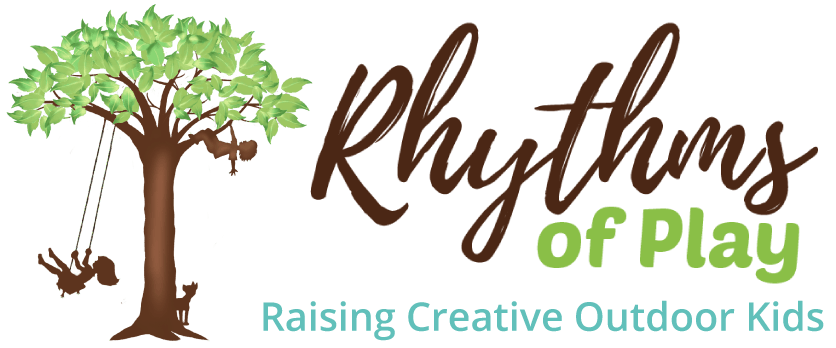
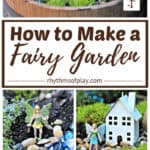
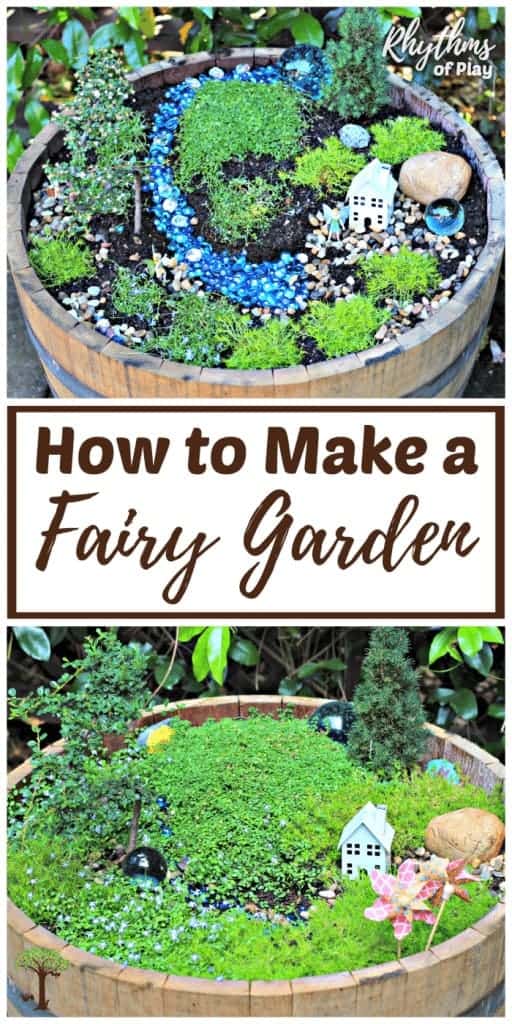
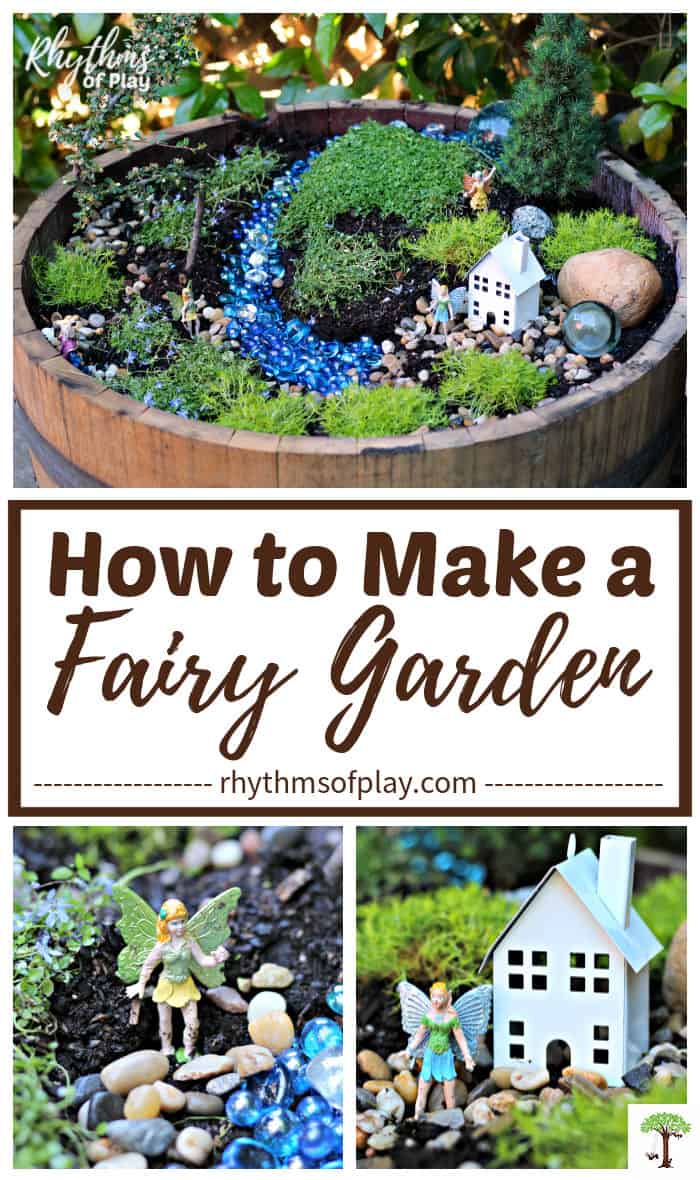

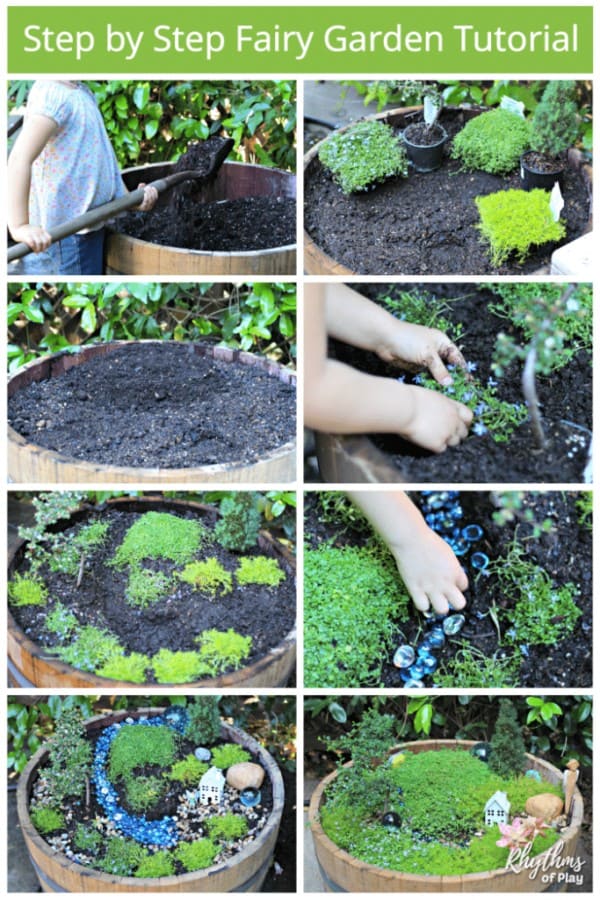
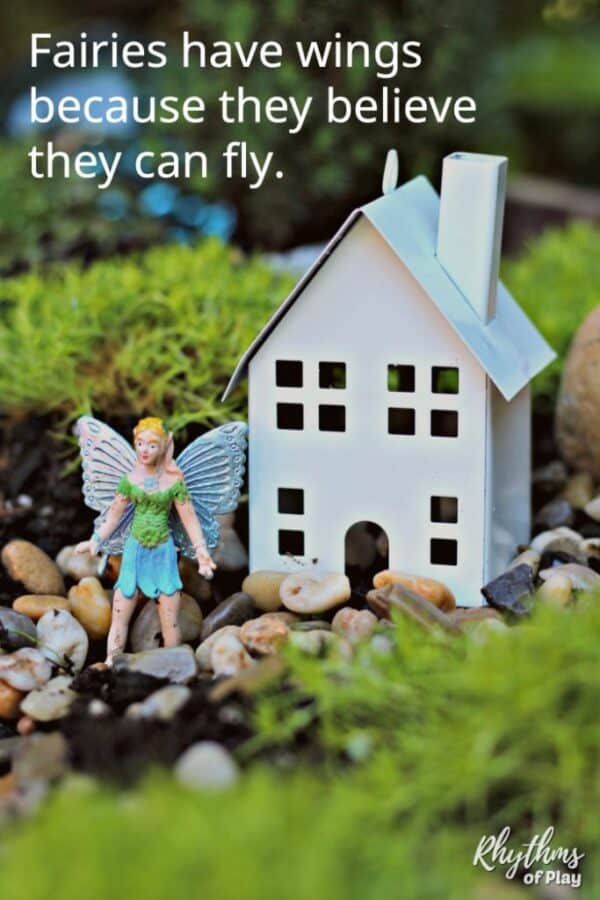
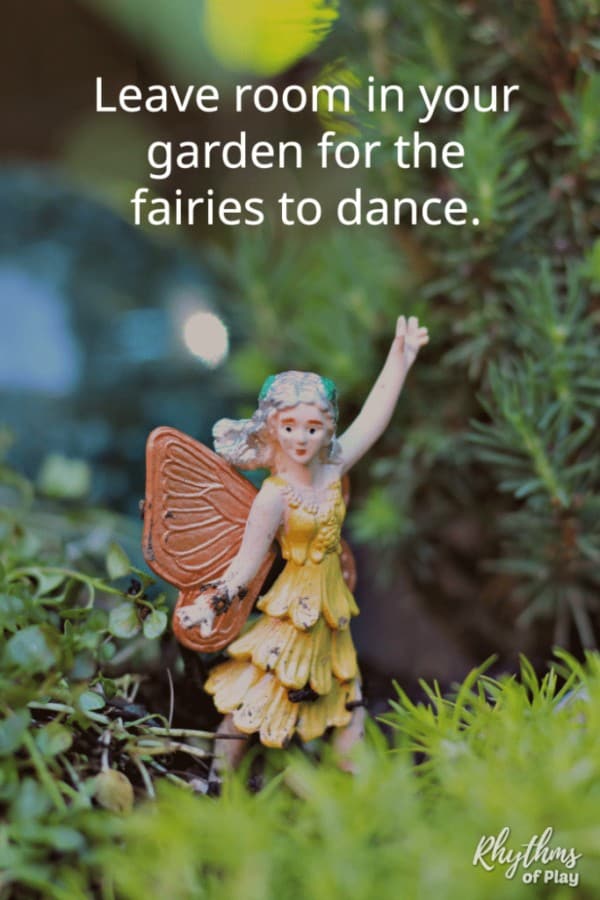
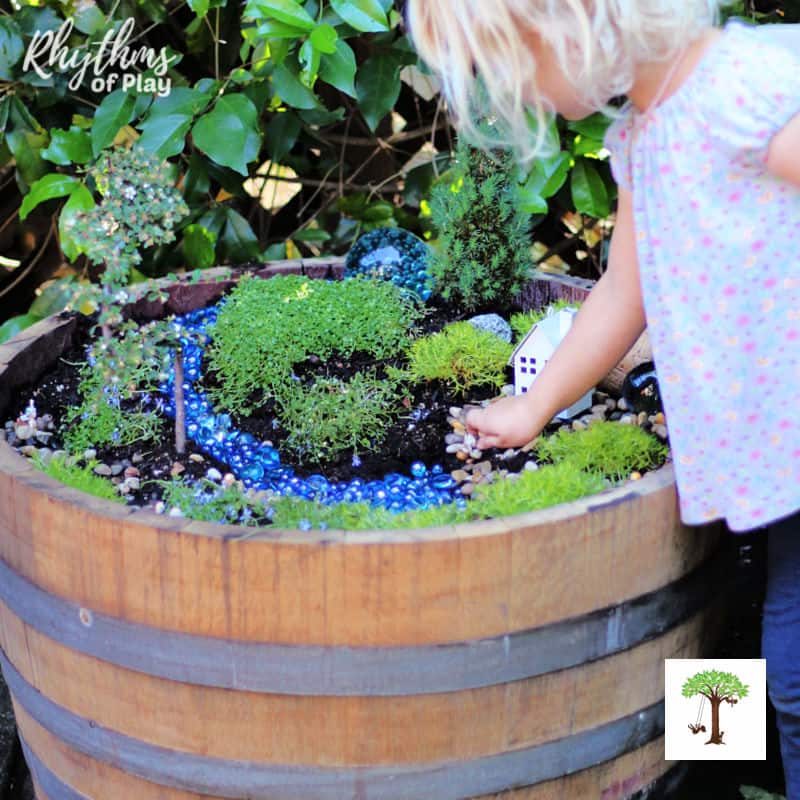
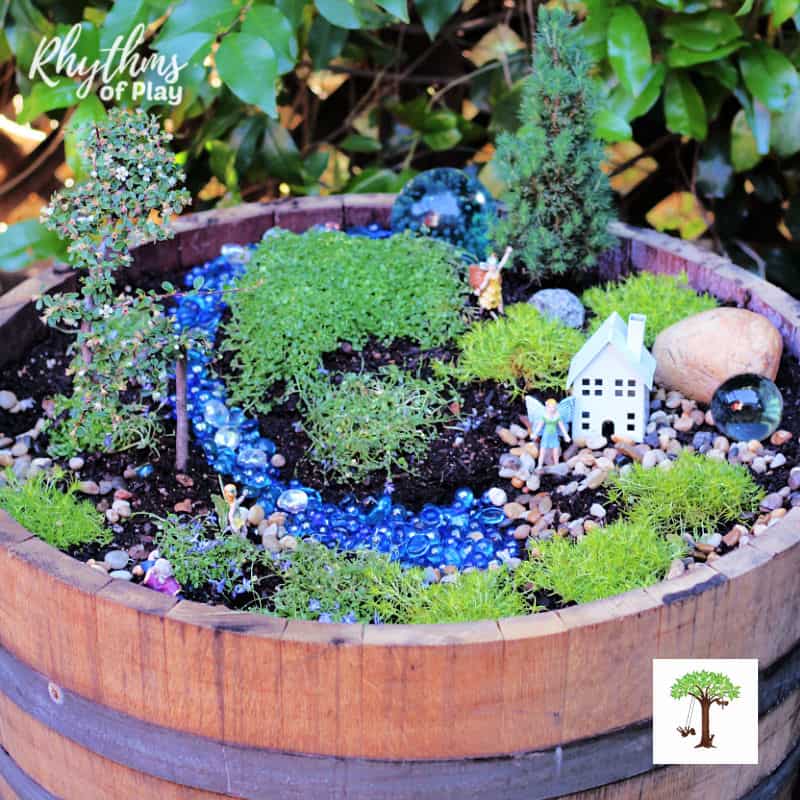
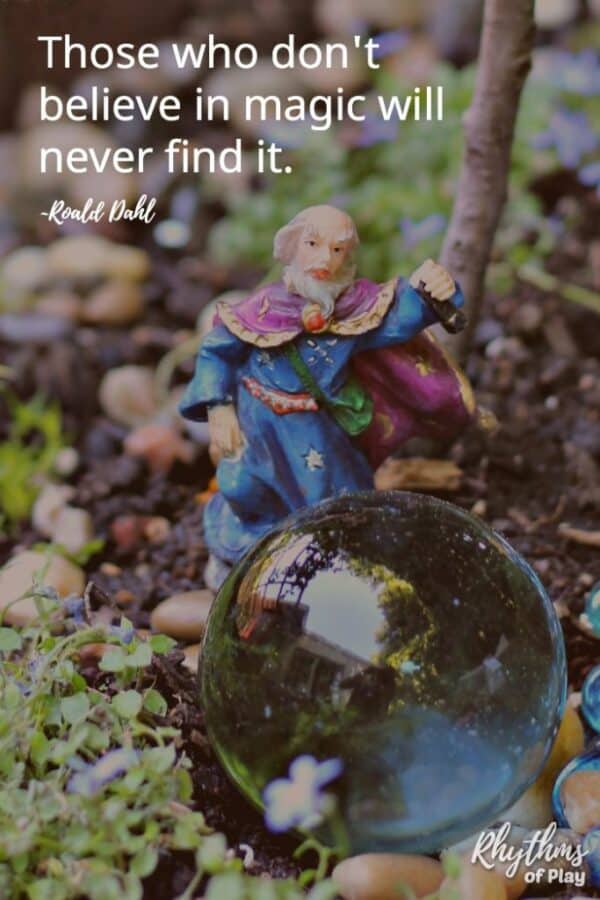

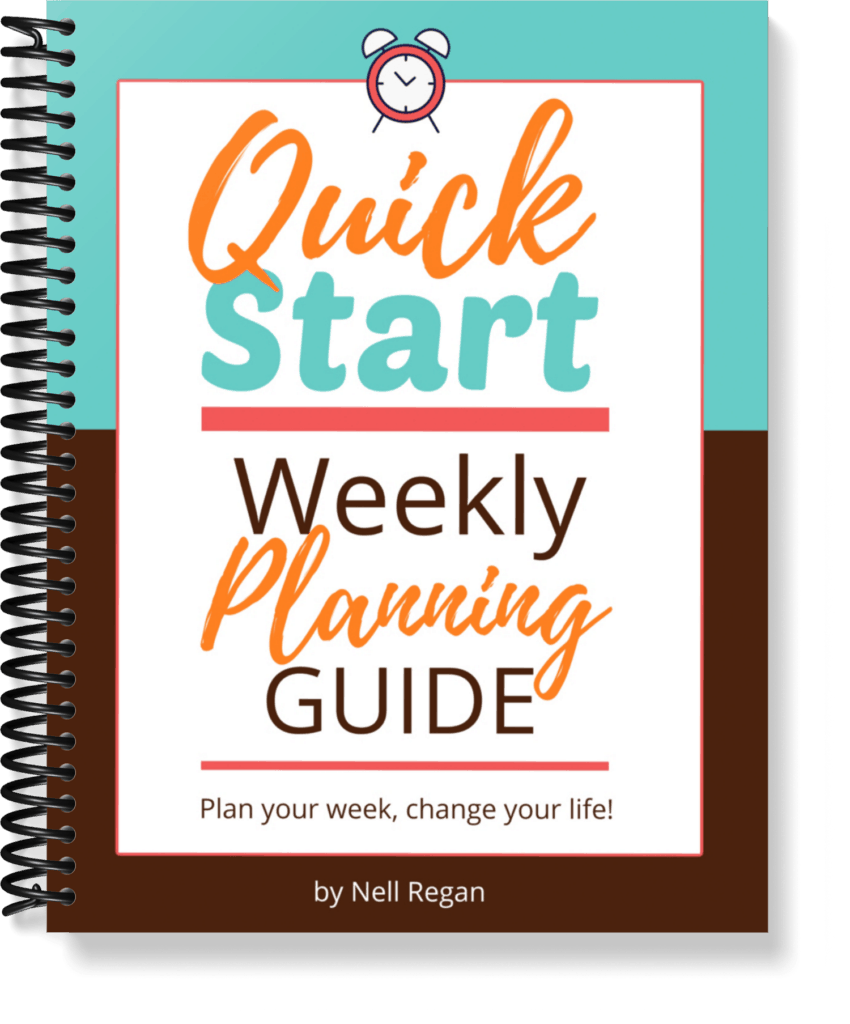
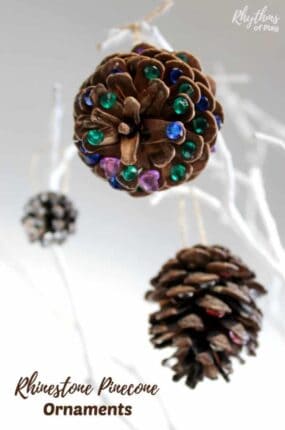

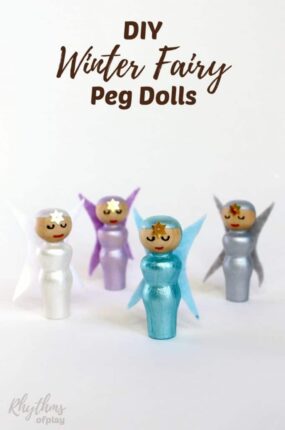
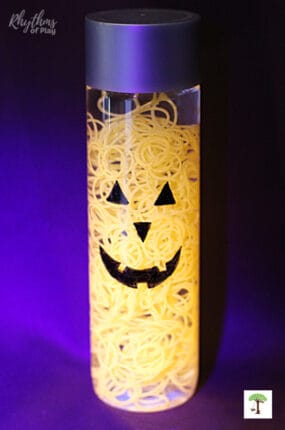
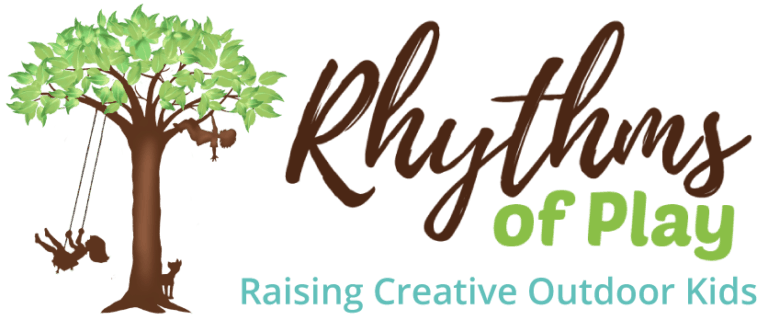
I’m looking forward making fairy garden. thank you for these instructions.
I’m so glad you found these fairy garden instructions and tips useful, Deborah! You will love tending it!
I like how you said that making a fairy garden gives children a space to play and develop their creativity. My sons have been playing outside a lot lately. I think I’ll use gnomes and small furniture to make a fun space for them.
Thanks, Amy!
We have a bunch of gnomes in our garden now as well.. they are wonderful! We found a bunch of great fairy garden accessories at Dollar Tree. Hurry before they are all gone!
Good Day to All. I am retired and live in desert of Nevada. I use a lot of succulents and I look forward to making a Fairy Garden, as I have acrage and lots of time. thanks for your encouragements. connie
You’re welcome, Connie! A succulent fairy garden would be lovely! We’d love to see some pictures of yours if you make one!
Ooh, I like what you said about how to water your fairy garden; use a watering can with a gentle pour spout or a hose with a spray nozzle attached. It’s also good to know that the quantity of water a fairy garden requires will vary depending on the climate, the setting, and the kinds of plants growing there. I am now excited more than ever to get a handmade fairy garden where my kids and I can spend magical moments together
I’m so glad that you found this DIY fairy garden tutorial helpful and are excited to make your own miniature garden. Enjoy!